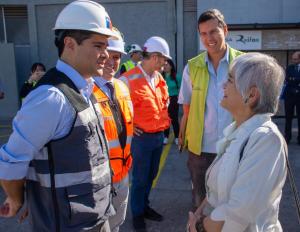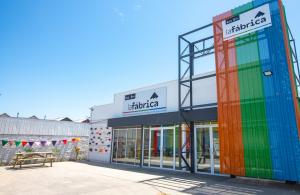 Read More
Read More
The innovation ‘factory’ helping a small city punch above its weight

Mayor Claudio Castro (background right) created La Fábrica as a vehicle for bringing new resources and expertise into local problem solving. Photos courtesy La Fábrica de Renca
Listen to This Article
When Claudio Castro was elected mayor of Renca, Chile, in 2016, he knew that he and his team would need additional resources to effectively take on the small city’s most entrenched challenges, from high poverty to dilapidated infrastructure. He also understood that securing those resources would require that residents, businesses, and civil servants believe that greater things were possible—that Renca could overcome its image as a poor, unsafe municipality on the outskirts of Santiago.
It was with all of that in mind that Castro decided to start something new called La Fábrica, or the Factory. At its core, it’s an external team dedicated to securing and deploying private capital in service of mayoral priorities. It’s housed in a nonprofit corporation, which helps it raise and spend money quickly, yet it also works closely enough with city agencies to ensure its activities take their efforts to the next level. Over its first five years, La Fábrica has helped leaders in a city of 160,000 people secure tens of millions of dollars to finance construction of new parks and other initiatives. But it’s not just the money; La Fábrica has emerged as a gateway to universities, philanthropies, and other partners who can help permanently change how the city solves problems.
Here are some of the key lessons coming out of this work about creating a new vehicle to quickly mobilize resources, connecting city agencies with new opportunities, and providing a physical space where residents can seek new skills and services.
Creating a new vehicle to rapidly mobilize resources.
As Mayor Castro set out to create an innovative city with a problem-solving capacity that defied its troubled image, he first focused on what he describes as personal diplomacy. That meant working with businesses to understand the roles they could play in improving the city and, with that understanding, align their strategic initiatives and investments accordingly. But he soon realized this work would need to be institutionalized if it was to succeed at scale and endure.
“We had to build a capacity that was different from the traditional culture of the municipality,” Mayor Castro recalls thinking.
That’s where La Fábrica comes in. The institution is, first and foremost, geared at connecting the city with the business community in a more systematic way. Where the city might previously have sought one-off engagements with companies that, in the end, represented drops in the bucket of local need, La Fábrica works with universities to produce the research needed to make the case for major corporate investment.
La Fábrica gets involved in virtually every major challenge the city tackles, a process made easier by their joining Monday “summit” meetings alongside department heads in city hall. Sometimes the need for their help is obvious, such as when key elements of the local strategic plan calling for new infrastructure projects are unfunded. Sometimes the team gets activated at the direct urging of the mayor, who might flag an opportunity. And at other times, they step in when individual agencies reach out for help in launching a new collaboration.
Backed by an annual budget of only $300,000, La Fábrica has so far helped the city secure $22 million in corporate investment for local improvements, including nearly 500 acres of new parks. It has also supported the rollout of a new fleet of electric buses and initiatives such as a digital skills-building program for youth while securing millions of dollars for additional infrastructure projects in the years ahead.
Connecting civil servants to partners and possibilities.
La Fábrica serves as an intermediary when projects that it has helped fund move forward, providing assurance to businesses that their money is being spent wisely. But the team also functions as a bridge between civil servants and support they need to do their jobs more effectively.
That might mean offering civil servants an opportunity to gain new data skills so they can, for example, better track trends in local drug use, as was a focus of Renca’s participation in the Bloomberg Philanthropies City Data Alliance. (It was La Fábrica that worked on the city’s behalf to forge a relationship with Bloomberg Philanthropies, as it does with many actors in the international community.) Or it might mean injecting a dose of human-centered design where it’s missing. For example, La Fábrica worked with city staff to improve a municipal chatbot, a project that did not involve corporate investment but did represent an opportunity to help the city operate more effectively and be more attractive to future private-sector contributors.
Ultimately, La Fábrica has helped cultivate a mindset across the civil service where agency teams raise their own game, with or without help from professional innovators.
Mayor Castro gives the example of his environmental services staff. “They have to keep the streets clean and the parks green,” he says. And now that La Fábrica has brought new resources to the table and helped them build up a track record of greater success, he sees a new ambition among agency staff to get ahead of future challenges, such as reducing carbon emissions. That same environmental services team is now playing a key role in a nearly $15 million park project that will create new greenspace, cool the city, and improve access to clean water.
Serving as an innovation hub that really delivers.
In addition to its focus on bringing in and optimizing investments for the city, La Fábrica is also a physical space that connects residents with new services, skills, and opportunities.
Its headquarters are on the site of a former Walmart along one of Renca’s major arteries. Now, residents can go there to receive critical services, such as a community optician and pharmacy, which are offered by city agency partners just outside La Fábrica’s doors. And they can benefit from job training offered in partnership with academia that they might otherwise not access.
“The promise to the community was that here, we will bring innovation and, in doing so, unlock services that the community has not even imagined,” explains Javier Morales, La Fábrica’s executive director.
Bringing people into the center continues to be a top priority, which is why, as La Fábrica’s team works behind the scenes to help generate the resources needed for new solutions, they're also finding new ways to attract residents to their space. For instance, they recently partnered with a bank to offer free financial counseling. That bank has also installed a new ATM, which is especially welcome in Renca, which only has 15 other ATMs across the whole municipality.
But what most distinguishes the space is that it serves as a symbol for a city that has begun to find its way.
“Everyone wants to go there, not only the neighborhood, the neighbors, but also the CEOs of the private firms,” Mayor Castro says. “They want to get to know La Fábrica and to be part of it.”


